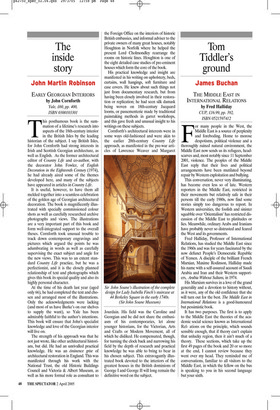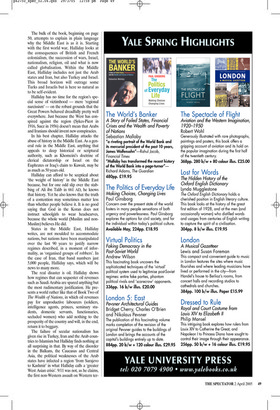Tom Tiddler’s ground
James Buchan
THE MIDDLE EAST IN INTERNATIONAL RELATIONS by Fred Halliday CUP, £16.99, pp. 392, ISBN 0521597412 For many people in the West, the Middle East is a source of perplexity and foreboding. Home to morose despotisms, political violence and a thoroughly ruined natural environment, the Middle East now sends us its refugees, headscarves and, most notably since 11 September 2001, violence. The peoples of the Middle East reply that their lives and political arrangements have been mutilated beyond repair by Western exploitation and bullying.
This conversation, never very illuminating, has become even less so of late. Western reporters in the Middle East, restricted in their movements but relatively safe in their persons till the early 1980s, now find some stories simply too dangerous to report. In Western universities, the foolish and sinister squabble over ‘Orientalism’ has restricted discussion of the Middle East to platitudes or lies. Meanwhile, ordinary Arabs and Iranians have probably never so distrusted and feared the West and its governments.
Fred Halliday, Professor of International Relations, has studied the Middle East since the 1960s and was for years fascinated by the now defunct People’s Democratic Republic of Yemen. A disciple of the brilliant French Marxian, Maxime Rodinson, Halliday made his name with a self-assured account of Saudi Arabia and Iran and their Western supporters, Arabia Without Sultans, in 1974.
His Marxism survives in a love of the grand generality and a devotion to history without, as it were, any of the old confidence that she will turn out for the best. The Middle East in International Relations is a good-humoured but pessimistic book.
It has two purposes. The first is to apply to the Middle East the theories of the academic social science known as International Relations on the principle, which sounds sensible enough, that if theory can’t explain that unlucky region, then it ain’t much of a theory. These sections, which take up the first 49 pages of the book and 20 or so more at the end, I cannot review because they went over my head. They reminded me of conversations, familiar to all visitors to the Middle East, in which the fellow on the bus is speaking to you in his second language but your sixth. The bulk of the book, beginning on page 50, attempts to explain in plain language why the Middle East is as it is. Starting with the first world war, Halliday looks at the consequences of British and French colonialism, the succession of wars, Israel, nationalism, religion, oil and what is now called globalisation. Within the Middle East, Halliday includes not just the Arab states and Iran, but also Turkey and Israel. This broad horizon will outrage some Turks and Israelis but is here so natural as to be self-evident.
Halliday has no time for the region’s special sense of victimhood — mere ‘regional narcissism’ — on the robust grounds that the Great Powers behaved dreadfully pretty well everywhere. Just because the West has conspired against the region (Sykes-Picot in 1916, Suez in 1956) doesn’t mean that Arabs and Iranians should invent new conspiracies.
In his best chapter, Halliday attacks the abuse of history in the Middle East. As a general rule in the Middle East, anything that appeals to deep historical or scriptural authority, such as Khomeini’s doctrine of clerical dictatorship or Israel on the Euphrates or Iraq’s claim to Kuwait, may be as much as 50 years old.
Halliday can afford to be sceptical about ‘the weight of history’ in the Middle East because, but for one odd slip over the stabbing of Ali ibn Talib in 661 AD, he knows that history. Yet he also knows that the truth of a contention may sometimes matter less than whether people believe it. It is no good saying that God in the Koran does not instruct schoolgirls to wear headscarves, because the whole world (Muslim and nonMuslim) believes He did.
States in the Middle East, Halliday writes, are not moulded to accommodate nations, but nations have been manipulated over the last 90 years to justify narrow regimes described, in a moment of informality, as ‘organised groups of robbers’. In the case of Iran, that band numbers just 5,000 people, Halliday says, which will be news to many more.
The real disaster is oil. Halliday shows how regimes that can sequester oil revenues such as Saudi Arabia are spared anything but the most rudimentary justification. He presents a world rather like that of Book Two of The Wealth of Nations, in which oil revenues pay for unproductive labourers (soldiers, intelligence agents, princes, seminary students, domestic servants, functionaries, secluded women) who add nothing to the prosperity of the country and will, in the end, return it to beggary.
The failure of secular nationalism has given rise in Turkey, Iran and the Arab countries to Islamism but Halliday finds nothing at all surprising in that. By way of the disorder in the Balkans, the Caucasus and Central Asia, the political weaknesses of the Arab states have infected a region ‘from Sarajevo to Kashmir’ in what Halliday calls a ‘greater West Asian crisis’. 9/11 was not, as he claims, the first non-Western assault on Western ter ritory in modern times — what about Pearl Harbor? — but it was a drastic break with the past in both strategic direction and aggression. There is something very strange, in the context of the modern Middle East, about the Madrid train bombings.
That brings us to Iraq, where Halliday adopts a perspective so long that the rashnesses of the US and UK governments are all but invisible. For Halliday, the invasion of 2004 was the fourth Gulf War: in other words, the last act in the slow-motion selfdestruction of Saddam Hussein and the Iraqi Baath since 1968.
Yet it is here that Halliday lets the unexpected or contingent into his theorising. He argues that Saddam invaded Kuwait in 1990 because he did not realise the Cold War was over only, by a celestial double irony, to be proved right after all. ‘On what was the most important question, the immunity of his regime, Saddam therefore calculated correctly.’ Here, and in a footnote on page 163 listing nine sets of historic misjudgments beginning with the Young Turks and ending with Saddam, we have a view of Middle Eastern history far more profound and persuasive than anything from social science.































































 Previous page
Previous page